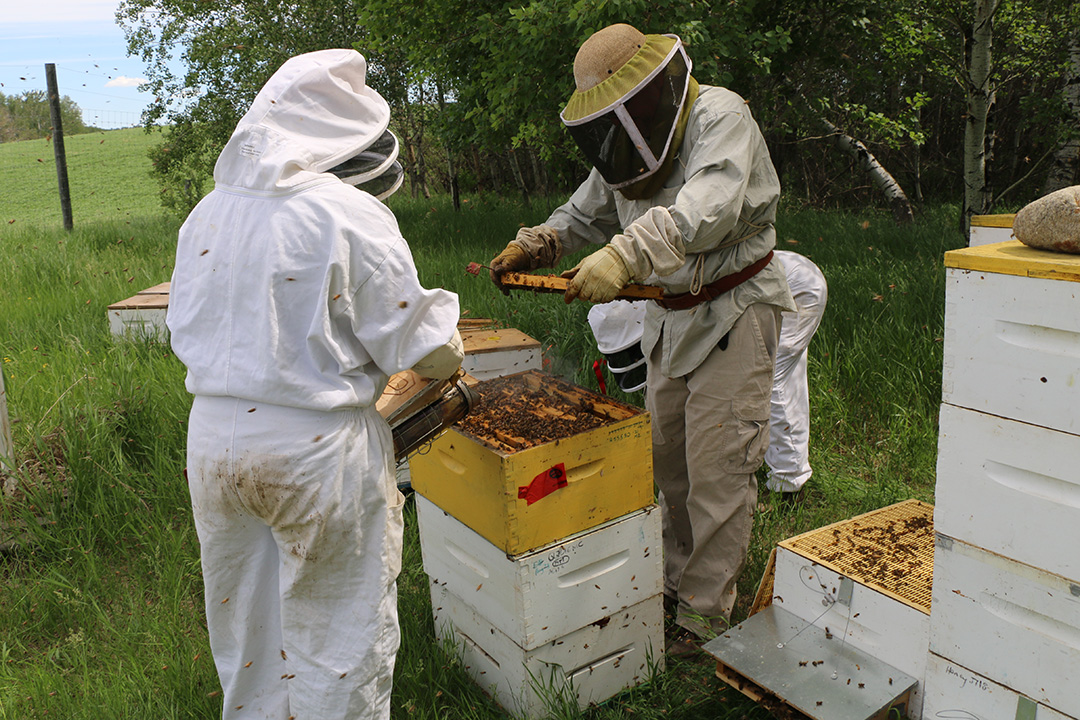
USask scientists test agent for controlling tiny mite that's a big issue for honey bees
Canadian beekeepers lost a third of their bee hives during the 2022-23 winter due to a “perfect storm” of factors that killed off millions of honey bees across the country.
By Emilio Enrique Tellarini PrietoParasites, disease, pesticides, intensive agriculture practices, climate change and the quality of queen bees all contributed to the industry’s losses. But out of all these pressures, the most threatening stressor is the tiny Varroa mite.
Varroa destructor is a parasitic mite, that lives on the external surface of bees’ bodies. They reproduce quickly and can overwhelm a honey bee colony in about six months to two years.
When Varroa mites infest honey bee colonies and feed on adult larval bees, these infestations harm bees in many ways. They shorten the bees’ lifespan, affect their metabolism, reduces their ability to reproduce, and make them more likely to contract viral infections.
Varroa mites cause indirect harm by reducing bee populations weakening colonies and making them more susceptible to extra environmental stressors. As well, they contribute to decreased honey production due to depleted foraging efforts and compromised health of worker bees.
The loss of so many bees in one year has been a significant blow for Canada’s honey production as well as for the country’s agriculture industry. The European honey bee (Apis mellifera L.) — the most common honey bee species — is among the most abundant and prolific pollinator in the world, renowned for its honey production and for playing a critical role in agriculture and food production.
According to the Agriculture and Agri-Food Canada’s estimates in 2021, the total annual economic contribution of honey bee pollination through direct additional harvest value was about $3.18 billion. Combined with hybrid canola seed production, that total rose to $7 billion per year.
Controlling this parasite has become very challenging because of the phenomenon of “resistance.” When the European honey bee was brought into Asia for apicultural purposes in the 1940s, Varroa mites initiated their massive global expansion. Since then, beekeepers have relied on synthetic pesticides to control Varroa mite infestations. But through repeated — and often incorrect — use of this substance, the mites have developed resistance to the chemicals and continue to multiply even when exposed to lethal products.
The search for effective and safe Varroa control alternatives has increased in recent years. For example, oxalic acid has emerged as an important area of research in apiculture. This organic acid has been used in many parts of the world such as South America and Europe. So far, there’s enough scientific evidence to show that oxalic acid has high efficacy rate against Varroa mites, and no one has reported any signs of resistance in the parasites.
However, beekeepers in other regions have been slower to adopt the oxalic acid use — mainly because of disagreements about its safety for different beekeeping conditions and systems.
In recent years, more Canadians in the industry are using vaporized oxalic acid as a control tool against Varroa mites. To use this method, beekeepers use a vaporizer to turn oxalic acid crystals into vapour — and then introduce the vaporized product into the hive. At the same time, researchers have observed that many beekeepers are applying much higher doses than what’s recommended on the product’s label.
To address this problem, University of Saskatchewan (USask) researchers from the honey bee health lab at the Western College of Veterinary Medicine (WCVM) conducted a field study during the summer of 2023. The team’s members included veterinarians, agronomists and biologists, and the study’s lead was Dr. Sarah Wood, a veterinary pathologist who holds the USask Pollinator Health Research Chair.
The experiment’s main goal was to test oxalic acid’s toxicity to adult bees and the queen. Members of the research team exposed honey bees hive to increasing amounts of vaporized oxalic acid, using doses that were five, 10 and 20 times the recommended amount.
The team then assessed any harmful effect on adult bees and their queen, evaluating adult bee mortality, brood production variations, population size, queen performance and sperm quality.
The study’s results showed that only the extreme dose of 20 times the recommended amount had a negative impact on bee health. The high dosage of oxalic acid caused a statistically significant increase in worker bee mortality and a non-statistically significant, 25 per cent decrease in brood production. Research findings showed no significant differences in the performance or sperm quality of the other groups.
While these results indicate that vaporized oxalic acid is an efficient Varroa mite control agent that doesn’t affect bee health, the researchers’ next step is to conduct further studies that will help to determine the safest and most effective type of application for oxalic acid.
MITACS, Saskatchewan Beekeepers Development Commission, BASF, British Columbia Blueberry Council, Manitoba Canola Growers, and SaskCanola have provided funding for this research.
Emilio Enrique Tellarini Prieto of Bahia Blanca, Argentina, is a master’s student in the Department of Veterinary Pathology at the Western College of Veterinary Medicine (WCVM). His graduate supervisor is Dr. Sarah Wood, the USask Pollinator Health Research Chair.
